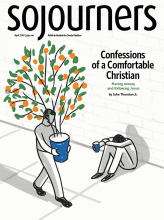ON JAN. 7, I was in St. Paul, Minn., where Peggy Flanagan was sworn in as Minnesota’s lieutenant governor. Peggy has been a close friend and ally of Sojourners for many years, serving as a member of our board executive committee, and she has been like a daughter to me and my family.
What I saw and heard from Peggy could be a glimpse of the future of American politics. It felt so different from the divisive political situation I had just come from in Washington, D.C. It was a historical moment as Peggy Flanagan was sworn in as the highest-ranking Indigenous woman ever elected to a state’s executive office. I would like to give my space to present her words, adapted from her inaugural speech:
“MY STORY IS a One Minnesota story. It’s about community. We didn’t have much growing up. What little we had, my mom used to make sure we got ahead. But it didn’t always add up. We needed help. I was the kid with the different-colored lunch ticket. We needed those free meals at school. Medicaid saved my life. As a kid with asthma, it’s the reason I’m alive today.
Growing up wasn’t always easy, but it made me strong. I stand before you today because of a loving family, a supportive community, and a great state. My vocation is to create community across Minnesota—a community like mine that lifts people up and provides them a little help when they need it.
Read the Full Article

